
Gobiidae is a family of bony fish in the order Gobiiformes, one of the largest fish families comprising more than 2,000 species in more than 200 genera, sometimes referred to as the "true gobies". Most of them are relatively small, typically less than 10 cm (3.9 in) in length. The Gobiidae includes some of the smallest vertebrates in the world, such as Trimmatom nanus and Pandaka pygmaea,Trimmatom nanus are under 1 cm long when fully grown,then Pandaka pygmaea standard length are 9mm (0.35 in),maximum known standard length are 11 mm (0.43 in). Some large gobies can reach over 30 cm (0.98 ft) in length, but that is exceptional. Generally, they are benthic, or bottom-dwellers. Although few are important as food for humans, they are of great significance as prey species for commercially important fish such as cod, haddock, sea bass, and flatfish. Several gobiids are also of interest as aquarium fish, such as the dartfish of the genus Ptereleotris. Phylogenetic relationships of gobiids have been studied using molecular data.

Mudskippers are amphibious fish, presently included in the family Oxudercidae, in the subfamily Oxudercinae. There are 32 living species of mudskipper.
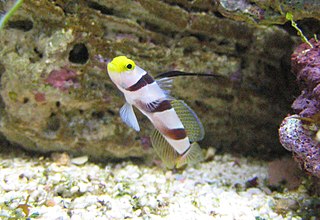
Stonogobiops nematodes, the Filament-finned prawn-goby, the high-fin goby, the red-banded goby, the high-fin red-banded goby, the striped goby, the barber-pole goby, or the black-ray Goby, is a species of marine goby native to the Indian Ocean and western Pacific Ocean from the Seychelles to the Philippines and Bali.
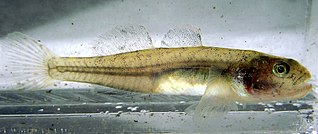
Eucyclogobius newberryi, the Northern tidewater goby, is a species of goby native to lagoons of streams along the coast of California, United States..

The black goby is a species of ray-finned fish found in the Eastern Atlantic and Mediterranean Sea and Black Sea. It inhabits estuaries, lagoons, and inshore water over seagrass and algae. It feeds on a variety of invertebrates and sometimes small fish. This species can also be found in the aquarium trade.

Amblyeleotris steinitzi, Steinitz' prawn goby or simply Steinitz' goby, is a species of small fish in the family Gobiidae. It lives in association with an alpheid shrimp and is found from the Red Sea through the Indian Ocean to the western Pacific Ocean.

The sleepy goby is a species of fish in the family Gobiidae.
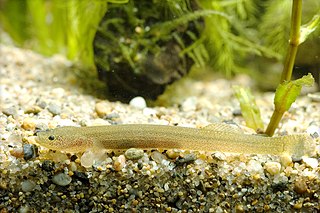
Luciogobius is a genus of goby in the subfamily, Gobionellinae. It is distributed along the coast of northeastern Asia, where species can be found in Korea, China, Taiwan, and Japan. Most species occur in Japan, and several are endemic.
Sicyopterus lagocephalus, the red-tailed goby or blue stream goby, is a species of goby native to islands of the Indian Ocean from the Comoros to the Mascarene Islands to the Pacific Ocean where it reaches French Polynesia and can be found as far north as Japan. It is an amphidromous species: adults can be found in swift-flowing streams with rocky beds but the eggs hatch at sea and the larval stage remains in marine waters, migrating to freshwaters when they reach the postlarval stage. This species can reach a total length of 13 cm (5 in). In some places it is an important species for local consumption with the post-larvae being caught as they mass in estuaries.
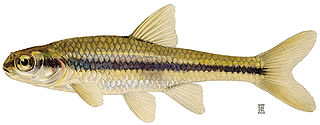
The bridle shiner is a member of the minnow family (Cyprinidae). This species has been identified as being of Special Concern by the Committee on the Status of Endangered Wildlife in Canada (COSEWIC).

The Gobiiformes are an order of fish that includes the gobies and their relatives. The order, which was previously considered a suborder of Perciformes, is made up of about 2,211 species that are divided between seven families. Phylogenetic relationships of the Gobiiformes have been elucidated using molecular data. Gobiiforms are primarily small species that live in marine water, but roughly 10% of these species inhabit fresh water. This order is composed chiefly of benthic or burrowing species; like many other benthic fishes, most gobiiforms do not have a gas bladder or any other means of controlling their buoyancy in water, so they must spend most of their time on or near the bottom.

The violet goby is a species of goby native to marine, fresh and brackish waters near the Atlantic coast of North and South America from South Carolina in the United States of America, to northern Brazil. It prefers bays, estuaries and river mouths with muddy substrates. It is often marketed as the dragon goby or dragon fish.
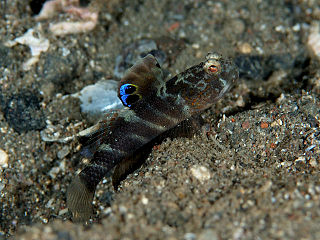
Mahidolia mystacina, the flagfin prawn goby, flagfin shrimpgoby or smiling goby, is a species of goby native to the Indian Ocean and the Pacific Ocean from Delagoa Bay, Mozambique to the Society Islands and from southern Japan to Samoa and northern Australia. This species occurs in marine and brackish waters, being found in coastal bays, estuaries and reef bases where the bottom is silty or muddy at depths of from 5 to 25 metres. This species is a commensal with a species of alpheid shrimp, using its burrow as its home. This species can reach a length of 8 centimetres (3.1 in) TL. This species can also be found in the aquarium trade. It is currently the only known member of its genus.
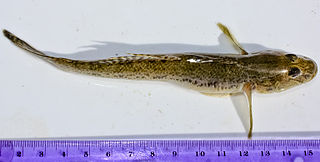
Acanthogobius flavimanus is a species of fish in the goby family known by the common name yellowfin goby. Other common names include mahaze, Japanese river goby, Oriental goby, and spotted goby. It is native to Asia, where its range includes China, Japan, Korea, parts of Russia, Vietnam, and Malaysia. It has spread beyond its native range to become an introduced, and often invasive, species. It has been recorded in Australia, Mexico, and Florida and California in the United States.
Arenigobius is a genus of gobies native to the Indian Ocean and the western Pacific Ocean.

The arrow goby is a species of goby native to marine and brackish waters of the Pacific coast of North America from British Columbia to Baja California. This species grows to a length of 6.4 centimetres (2.5 in) SL, though most do not exceed 4.2 centimetres (1.7 in) TL. This fish can also be found displayed in public aquaria. This species is the only known member of its genus.
The comb goby is a species of goby native to marine and brackish waters of the Indian Ocean and the western Pacific Ocean. This species occurs mostly on muddy substrates near mangrove forests. This species grows to a length of 18 centimetres (7.1 in) TL. This species is of minor importance to local commercial fisheries and can also be found in the aquarium trade. This species is the only known member of its genus. Paratrypauchen microcephalus has been recorded from areas which have soft, muddy bottoms, in estuaries and around the mouths of rivers near mangroves where they inhabit deep burrows in the mud. It is not known if they excavate the burrows themselves. This species feeds on benthic invertebrates such as crustaceans.
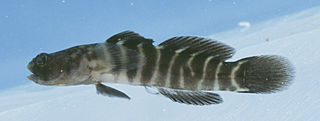
Gobiosoma bosc is a fish named for its lack of scales. This is a true goby; it is part of the genus Gobiosoma.
Arenigobius frenatus, commonly known as the half-bridled goby, is a fish native to the waters of eastern Australia. It occurs in the tropical and temperate waters of eastern Australia being distributed from Cape Tribulation, Queensland, to Flinders Island, Tasmania, and west along Australia's south coast to Port Phillip Bay, Victoria. It is normally encountered in pairs which live in burrows among seagrass beds or within mangroves in sheltered waterbodies such as bays, estuaries and coastal lagoons, at depths no deeper than 10 metres (33 ft). They feed on benthic invertebrates.
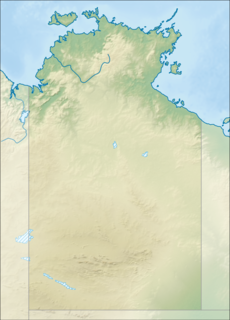
The Blyth River is a river in the Northern Territory, Australia.















